Burst mode is your secret weapon for capturing sharp action shots. It rapidly fires off multiple frames with a single shutter press, increasing your odds of nailing the perfect moment. You'll overcome camera shake, as the continuous shooting minimizes movement. With fast shutter speeds and continuous autofocus, you can freeze fast-moving subjects and maintain crisp focus. Burst mode also helps you adapt to changing lighting conditions and subject movements. While it can eat up storage space, the payoff is worth it. You'll have a series of shots to choose from, ensuring you don't miss that split-second of peak action. There's more to explore about maximizing this powerful technique.
Understanding Burst Mode
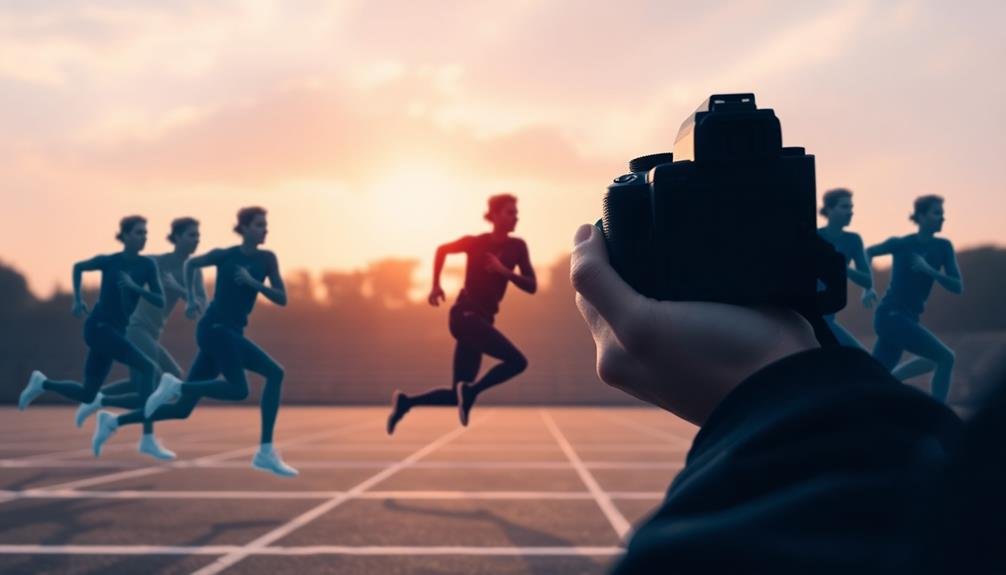
Burst mode releases a rapid-fire sequence of shots with a single press of the shutter button. It's a powerful tool that allows you to capture multiple frames per second, increasing your chances of getting the perfect shot in fast-moving situations. Most modern cameras, including smartphones, offer this feature.
When you engage burst mode, your camera continuously focuses and adjusts exposure between shots, ensuring each frame is as sharp as possible. The number of frames per second varies depending on your camera model, ranging from a few to over 20 for high-end DSLRs and mirrorless cameras.
You'll find burst mode particularly useful for action photography, sports events, wildlife shoots, or any scenario where timing is essential. It helps you capture fleeting expressions, peak moments in sports, or unpredictable animal behavior.
Capturing Peak Action Moments
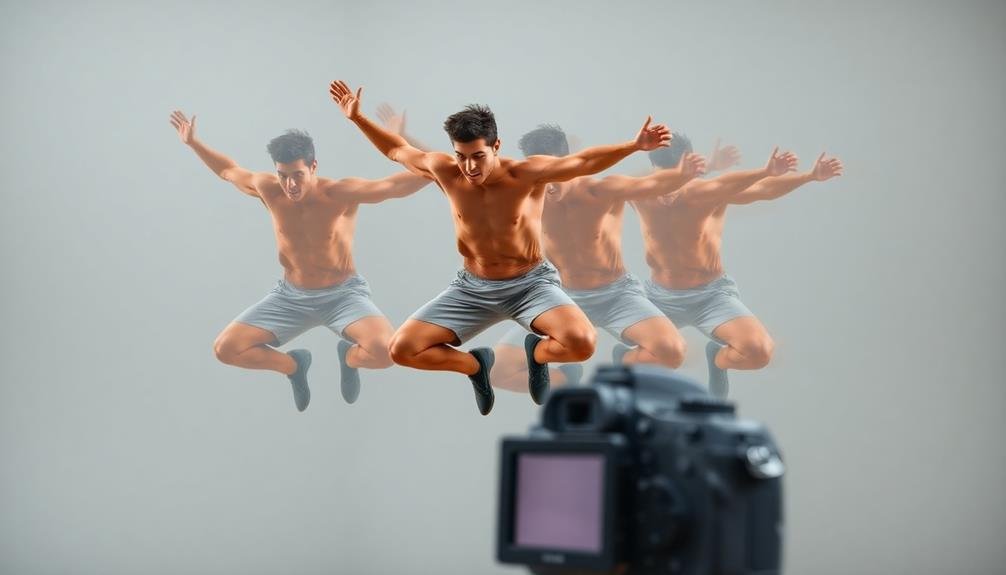
Anticipation is key when capturing peak action moments. You'll need to predict when the most exciting part of the action will occur and be ready to fire off your burst of shots at that precise instant.
Whether you're photographing sports, wildlife, or any fast-moving subject, timing is essential.
To capture peak action, you should familiarize yourself with your subject's movements. Watch for patterns and repetitive actions that'll help you anticipate the perfect moment.
For example, in sports, learn the typical motions of athletes as they prepare to jump, throw, or swing.
Set your camera to its highest burst rate and be prepared to shoot in short bursts rather than holding down the shutter continuously. This'll help you conserve memory card space and battery life while still increasing your chances of capturing the perfect shot.
Remember to keep your focus locked on the subject throughout the burst. Use continuous autofocus (AF-C) mode to track moving subjects effectively.
Increasing Chances of Sharp Focus
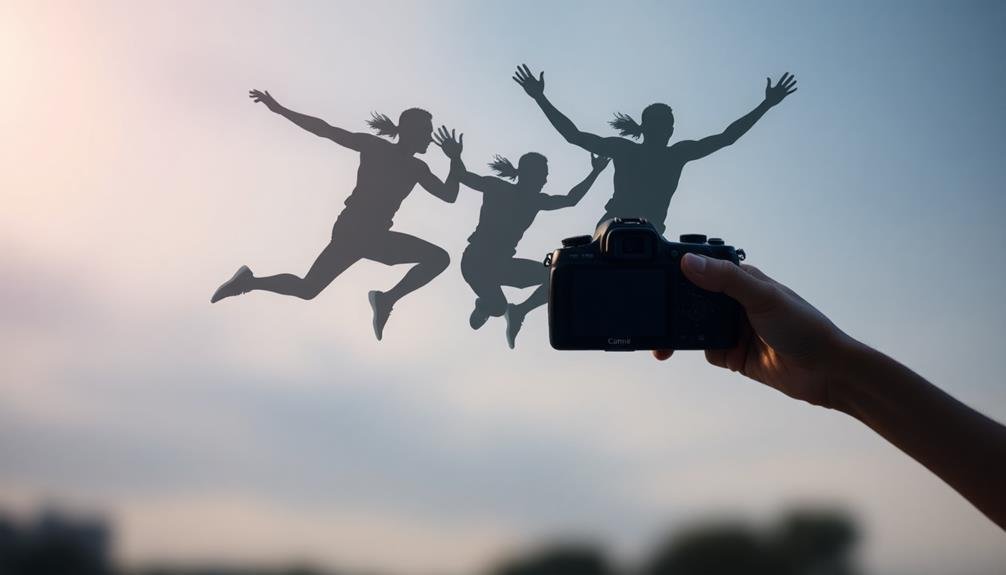
Photographers often struggle with achieving sharp focus in fast-paced scenarios. Burst mode considerably increases your chances of capturing tack-sharp images in these challenging situations. By rapidly firing off multiple shots, you're more likely to catch the perfect moment when your subject is in focus.
When you use burst mode, you'll benefit from:
- Improved timing: You'll have a series of images to choose from, increasing the likelihood of capturing the exact moment when your subject is in ideal position.
- Reduced camera shake: The continuous shutter action can help minimize camera movement, resulting in crisper images.
- Better autofocus performance: Many cameras' autofocus systems work more efficiently in burst mode, tracking moving subjects more accurately.
To maximize your success with burst mode, make sure you're using a fast shutter speed to freeze action.
Also, consider your camera's buffer capacity and write speed to avoid slowdowns during extended bursts.
Remember to select the appropriate autofocus mode for your subject's movement pattern. With practice, you'll find that burst mode becomes an invaluable tool for capturing sharp, dynamic action shots in various challenging scenarios.
Overcoming Camera Shake
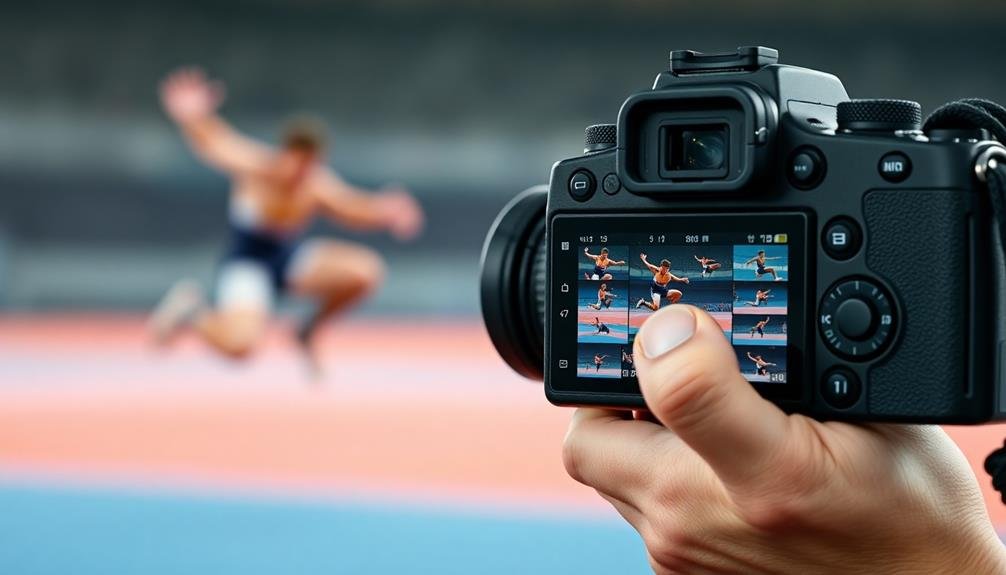
While burst mode can help minimize camera shake, it's not always enough on its own. To further reduce camera shake, you'll need to employ additional techniques.
Start by adopting a stable stance: plant your feet shoulder-width apart and tuck your elbows close to your body. This creates a more solid foundation for your shots.
Next, focus on your breathing. Take a deep breath, exhale partially, and hold it as you shoot. This momentary pause can greatly reduce body movement.
If possible, use a faster shutter speed to freeze motion and counteract slight camera movements. Increase your ISO if necessary to maintain proper exposure.
Consider using image stabilization if your camera or lens offers this feature. It can compensate for minor shake, especially in low-light situations.
For even more stability, use a monopod or tripod. These tools provide excellent support, allowing you to shoot at slower shutter speeds without introducing shake.
Lastly, practice proper trigger control. Gently squeeze the shutter button instead of jabbing it. This smooth action minimizes the risk of jarring the camera during the exposure, resulting in sharper images.
Selecting the Best Shot
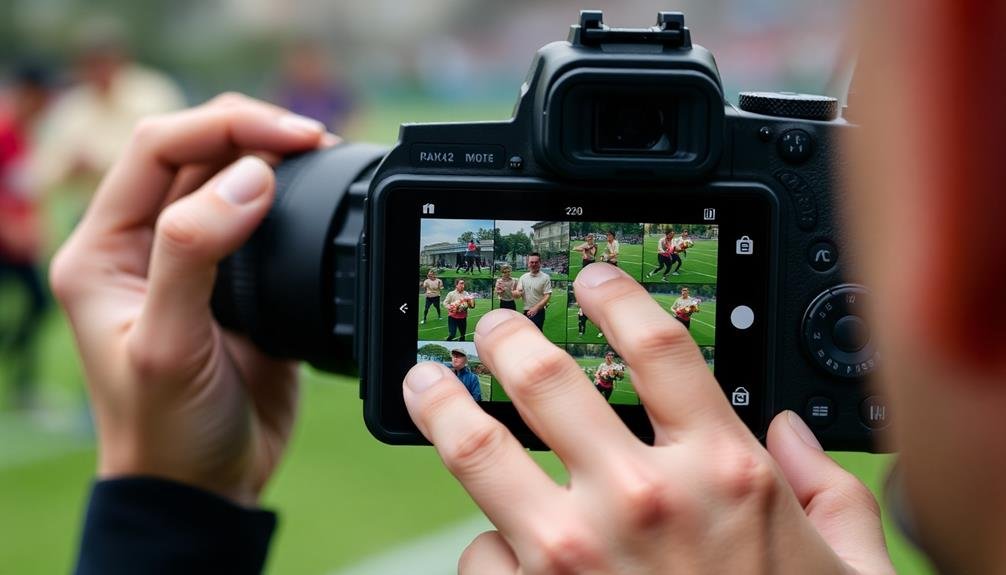
After capturing a burst of photos, you'll need to carefully review your shots to choose the best one.
Compare consecutive frames to spot subtle differences in action and expression, while analyzing subject positioning to guarantee the most dynamic composition.
Don't forget to assess technical elements like focus, exposure, and sharpness to select the image that best represents your vision.
Compare Consecutive Frames
Once you've captured a series of burst mode shots, it's time to compare consecutive frames and select the best one. This process allows you to find the perfect moment that captures the action at its peak. Look for subtle differences between frames, such as the positioning of limbs, facial expressions, or the interaction between subjects and their environment.
When comparing consecutive frames, focus on these key aspects:
- Sharpness: Check for the frame with the least motion blur and the most defined details.
- Composition: Look for the shot that best adheres to compositional rules or creates the most visually appealing arrangement.
- Timing: Identify the frame that captures the most impactful or decisive moment in the action sequence.
Don't rush this process. Take your time to examine each frame carefully, zooming in to check details if necessary. You might find that combining elements from different frames in post-processing creates the ideal image.
Analyze Subject Positioning
When selecting the best shot from your burst sequence, analyzing subject positioning is essential. Look for frames where your subject is in the ideal position within the frame. This often means centering the subject or placing them according to the rule of thirds, depending on your composition goals.
Pay attention to the subject's body language and facial expressions. You'll want to choose a shot that captures the most dynamic or emotive moment. For athletes, this might be the peak of their jump or the moment of impact. For portraits, it could be a genuine smile or a fleeting expression that reveals character.
Don't forget to take into account the background and other elements in the frame. The best shot should have minimal distractions and a clean composition. Check for unwanted objects entering the frame or awkward intersections with background elements.
Lastly, look at the subject's eyes. In most cases, you'll want to select a frame where the eyes are open and in focus. This is especially vital for portraits or close-up action shots.
Assess Technical Elements
Beyond subject positioning, you'll need to evaluate several technical elements when selecting the best shot from your burst sequence. Focus on sharpness, exposure, and composition to narrow down your options. Look for images where the subject is in crisp focus, especially around the eyes and key features. Check for proper exposure, ensuring highlights aren't blown out and shadows retain detail.
When evaluating your burst shots, pay attention to these critical technical aspects:
- Motion blur: Examine the subject and background for any unwanted blur that might detract from the image's impact.
- Depth of field: Assess whether the desired elements are in focus while the background is pleasingly blurred.
- Lighting: Look for shots where the light enhances the subject and creates appealing highlights and shadows.
Don't forget to reflect on the overall aesthetic appeal of each frame. Sometimes, a slightly less technically perfect shot might capture a more compelling moment or expression.
Trust your instincts and choose the image that best conveys the action and emotion of the scene. With practice, you'll develop a keen eye for quickly identifying the standout shots in your burst sequences.
Freezing Fast-Moving Subjects
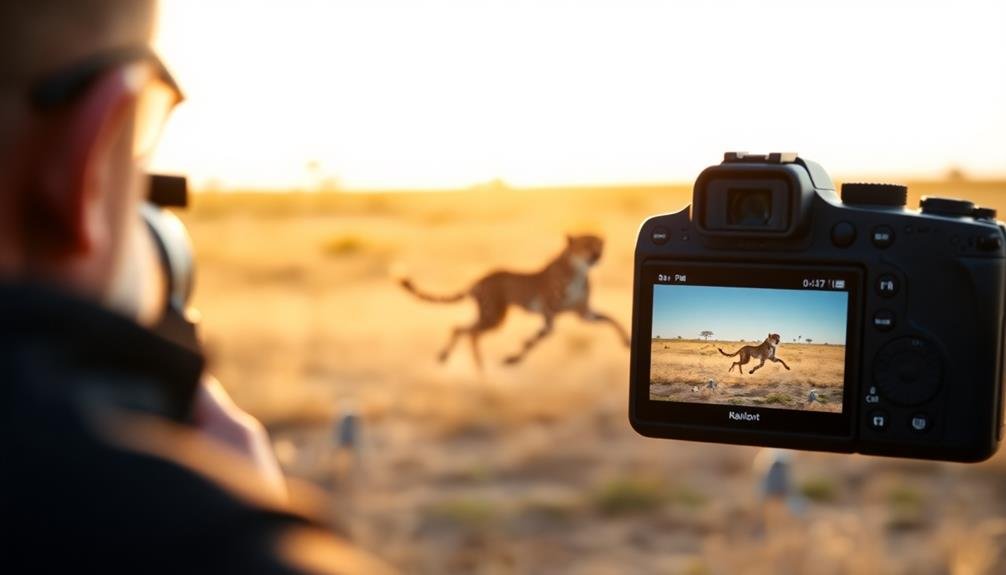
Three key elements work together to freeze fast-moving subjects: burst mode, fast shutter speeds, and precise timing.
When you're shooting action, burst mode allows you to capture multiple frames in quick succession, increasing your chances of getting that perfect shot. Set your camera to its highest continuous shooting speed for the best results.
Pair burst mode with fast shutter speeds to stop motion effectively. Depending on your subject's speed, you'll want to use shutter speeds of 1/500th of a second or faster.
For extremely fast subjects like racing cars or birds in flight, aim for 1/1000th or even 1/2000th of a second.
Timing is essential. Anticipate the peak of action and start shooting just before it happens.
This might mean pressing the shutter as an athlete begins their jump or as a car approaches a turn. With burst mode, you'll capture a series of images around this vital moment.
Compensating for Lighting Changes
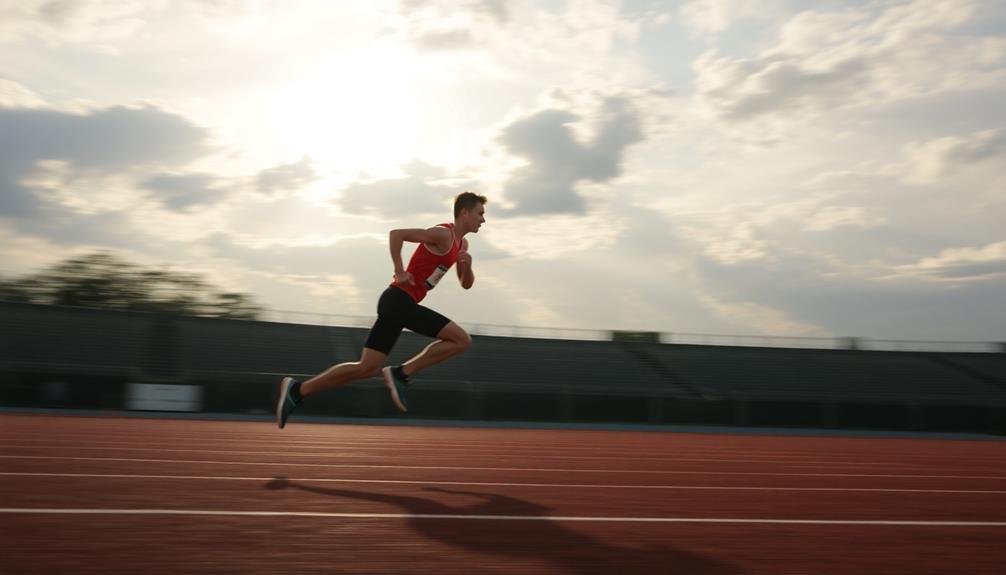
While burst mode and fast shutter speeds are key for freezing action, they can present challenges in changing light conditions.
You'll need to adapt quickly to maintain proper exposure as your subject moves through varying light intensities. This is where burst mode truly shines, allowing you to capture multiple shots with different exposures.
To compensate for lighting changes while using burst mode:
- Use auto-ISO: Enable this feature to let your camera adjust sensitivity on the fly, maintaining a consistent exposure across your burst.
- Switch to aperture priority mode: This allows you to control depth of field while the camera adjusts shutter speed to match changing light.
- Bracket your exposures: Set your camera to capture a series of shots at different exposure levels, ensuring at least one perfectly exposed image.
Conserving Storage Space
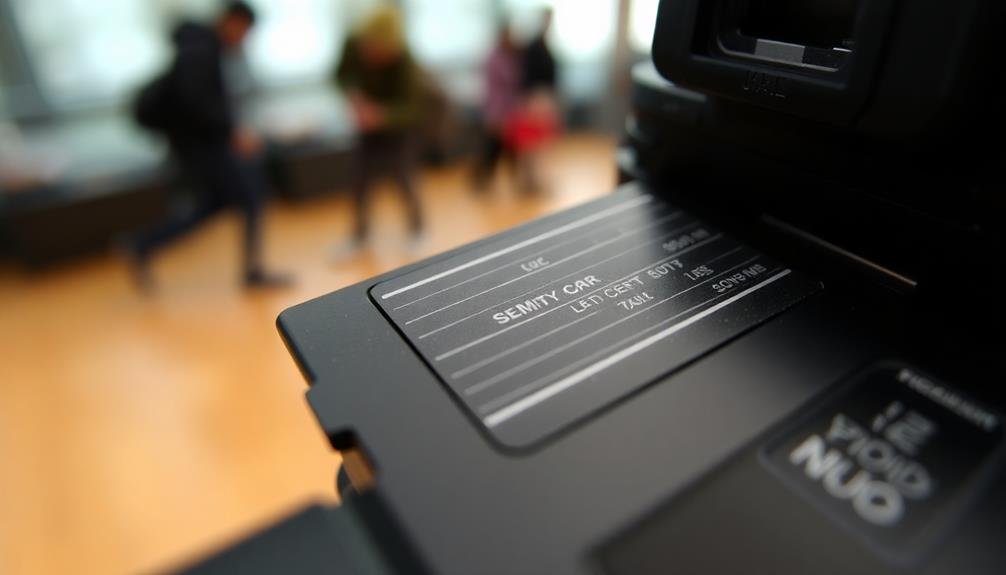
Burst mode can quickly fill up your memory card, especially when shooting RAW files. To conserve storage space while still reaping the benefits of burst shooting, you'll need to be strategic.
First, consider using a lower-resolution JPEG setting for burst shots. This will notably reduce file sizes without compromising too much on quality for most purposes.
You should also be selective about when you engage burst mode. Use it only for vital moments when you're likely to capture that perfect shot. Don't leave it on continuously, as this will lead to unnecessary photos and wasted space.
After each burst sequence, review and delete any subpar shots immediately.
Invest in high-capacity, fast memory cards to guarantee you don't run out of space during critical moments. If you're on an extended shoot, bring spare cards or a portable hard drive to offload images.
You can also enable in-camera RAW processing to create smaller JPEG versions of your favorite shots, allowing you to delete the larger RAW files if storage becomes an issue.
Frequently Asked Questions
How Does Burst Mode Affect Camera Battery Life?
Burst mode can drain your camera's battery faster. You're taking multiple shots in quick succession, which requires more power. It's best to have spare batteries handy if you plan to use burst mode extensively.
Can Burst Mode Be Used Effectively With Manual Focus?
Yes, you can use burst mode effectively with manual focus. It's challenging but rewarding. Pre-focus on your subject's expected position, then fire away. This technique works well for predictable movements or static subjects. Practice improves your timing and accuracy.
Are There Specific Camera Models That Excel at Burst Mode Shooting?
You'll find several cameras excel at burst shooting. High-end DSLRs like Canon's 1D X Mark III and Nikon's D6 offer impressive frame rates. For mirrorless options, consider Sony's A9 II or the Canon EOS R3 for exceptional burst performance.
How Does Burst Mode Impact Image Quality Compared to Single-Shot Mode?
You'll find burst mode generally maintains high image quality, comparable to single-shot mode. However, it may slightly reduce resolution or increase noise in some cameras due to faster processing. Overall, the impact on quality is usually minimal for most users.
Is Burst Mode Suitable for Low-Light or Nighttime Action Photography?
You'll find burst mode challenging for low-light action shots. It's often too slow in these conditions, leading to blurry images. Instead, you're better off using a wider aperture and higher ISO with single-shot mode.
In Summary
You've now seen why burst mode is your secret weapon for sharp action shots. It's not just about capturing the perfect moment; it's about increasing your chances of nailing focus, overcoming shake, and freezing motion. Remember, you're not wasting space—you're giving yourself options. So next time you're shooting fast-moving subjects or unpredictable scenes, don't hesitate. Switch to burst mode and let your camera do the heavy lifting.

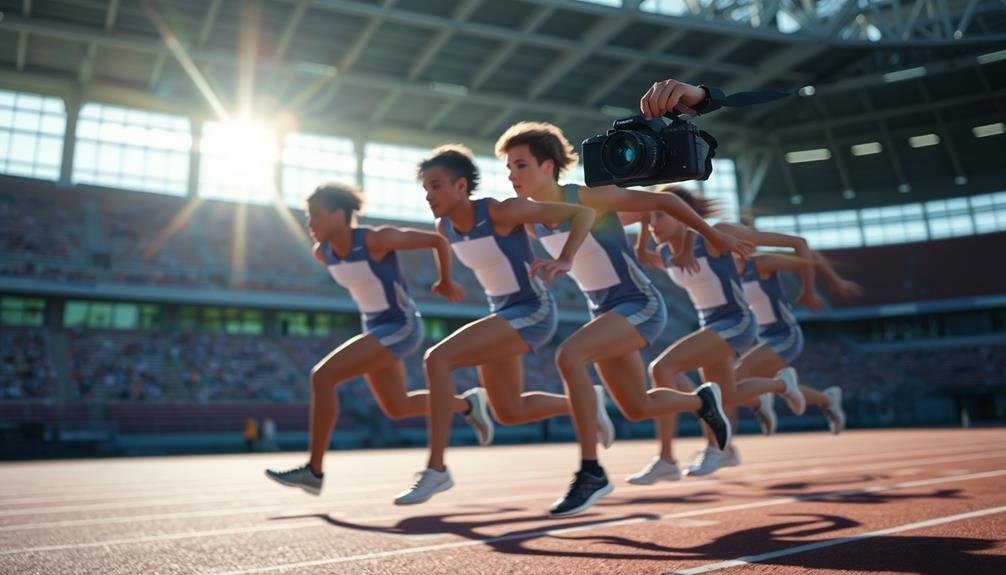



Leave a Reply